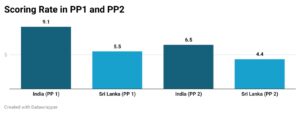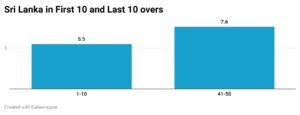Quick guide:
India vs Sri Lanka – 1st ODI Post Match Analysis
India started off the Sri Lanka tour on the perfect note as they won the first ODI by seven wickets at the Premadasa Stadium in Colombo. The Indian bowlers did well to restrict Sri Lanka to a chase able total of 262-9 and then the young Indian batters took the aggressive option as they chased down the total in just 36.4 overs.
Even though Shikhar Dhawan was the highest scorer, it was Prithvi Shaw and Ishan Kishan who set the tone for the run-chase. In the end it was an easy win for India as Sri Lanka didn’t show much fight. So let us have a look at the phase wise analysis for both the teams in the first ODI.
Batting and bowling averages in each phase
| Team | Phase | Batting Average | Bowling Average |
| Sri Lanka | 1-10 | 55 | 91 |
| India | 1-10 | 91 | 55 |
| Sri Lanka | 11-40 | 26.2 | 86 |
| India | 11-40 | 86 | 26.2 |
| Sri Lanka | 41-50 | 25.33 | – |
These numbers indirectly show that Sri Lanka kept losing wickets while India didn’t lose many wickets. Picking up wickets in any format of the game is crucial and the Indian bowlers did it better than the Sri Lankan bowlers. Sri Lanka kept losing wickets at regular intervals and couldn’t stich in big enough partnerships, whereas India on the other hand did that. If Sri Lanka can put together partnerships in the upcoming games, then they would be able to reach a defendable score.
The Indian batsmen seemed in great form and if they continue batting like this then Sri Lanka might find it difficult to contain them.
Powerplay Comparison

There is a huge difference in the scoring rate of both the teams in the powerplays. In the first powerplay, where only two fielders are outside the circle, India scored at a rate of 9.1 while Sri Lanka scored at a rate of 5.5. While, 5.5 runs per over is not a bad scoring rate but in comparison with India it looks way too low.
Both the teams lost a wicket each in the first powerplay. While chasing a total in the 260s if a team scores 90+ runs in the first powerplay then the game is pretty much done and dusted. Prithvi Shaw was the aggressor in the powerplay for India as he scored 43 off just 24 balls with nine fours. On the other hand, Sri Lanka were looking to set up a platform for the middle-overs.
It didn’t go as per plan for Sri Lanka in their middle-overs as their scoring rate dropped to 4.4 from 5.5 runs per over. Losing wickets at regular intervals was the main reason for this drop in the scoring rate. Even India’s scoring rate dropped in the middle-overs but still it was way above the required run-rate. The likes of Ishan Kishan and Suryakumar Yadav scored quick enough to maintain the scoring rate.
Comparison of first 10 and last 10 overs

Sri Lanka managed to increase their scoring rate in the death overs but ideally, they would have loved to score at more than 8 runs per over. Having said that, they had lost 6 wickets before the death overs started and so considering that, 76 runs in the last 10 overs is a decent effort. India was so good with the bat that they didn’t have to face the last ten overs. They finished off the run-chase in just 36.4 overs.
Read : Young Indian team humbles the Sri Lankan Team
Special Mentions
Shikhar Dhawan reached 6000 ODI runs and 10,000 international runs in the first ODI vs Sri Lanka.
Ishan Kishan became the only Indian to score a fifty on T20I as well as ODI debut.
Ishan Kishan scored his fifty off just 33 balls which is the second fastest fifty on debut, the fastest being of Krunal Pandya in just 26 balls against England earlier this year.
91 in Powerplay is the highest powerplay score by India in an ODI since 2013.
Krunal Pandya’s spell of 10-1-26-1 is the fifth most economical spell by an Indian bowler since 2015. Axar Patel’s 10-2-16-1 vs Zimbabwe being the most economical.
~Shubham Kulkarni (Stats analyst)
Follow us on socials: Twitter: @beyondmatches || Facebook: Beyond the Matches || Instagram: @beyondthematches
